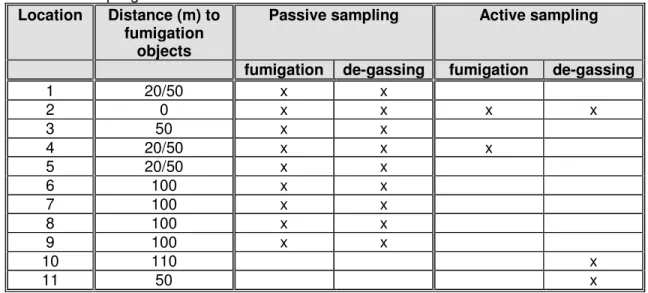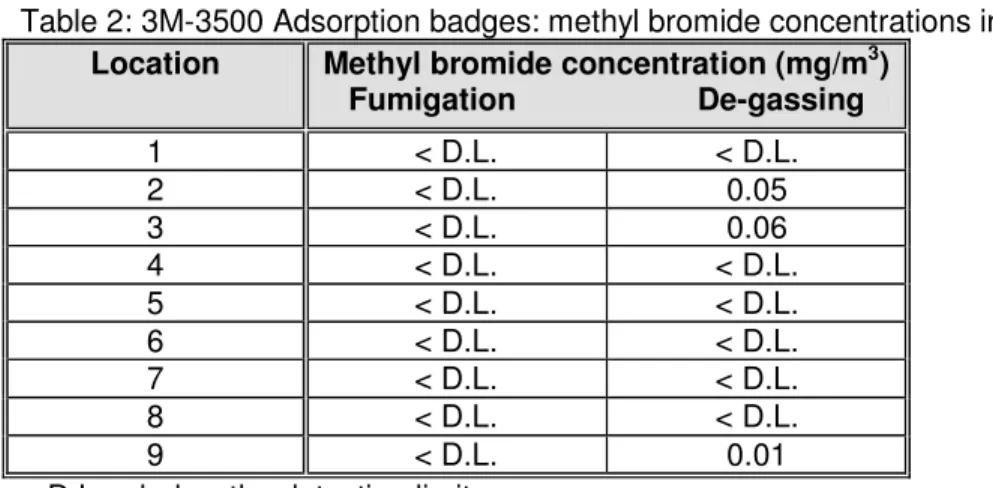LETTER REPORT
METHYL BROMIDE MEASUREMENTS DURING FUMIGATION AND DE-GASSING OF
SILOS AT MENEBA MEEL WORMERVEER B.V. ON 23, 24 AND 25 JUNE 2000, INWORMERVEER (THE NETHERLANDS)
On behalf of Mr W. Veldman, VROM Inspectorate regio Zuid-West CC
Author(s) Ms T. Knol
Status of report Definitive
Date June 2007 (English publication)
Report number IMD 609021047 RIVM number
This report comprises 7 pages (including this page )
This study was conducted in 2000 on behalf of the former Environmental Inspectorate
(Inspectie Milieuhygiëne). The original report was published in Dutch in 2000 and had report number 435/00 IEM/tk
TABLE OF CONTENTS
1. INTRODUCTION... 3 2. AIM... 3 3. IMPLEMENTATION ... 3 3.1 FUMIGATION... 3 3.2 MEASUREMENTS... 53.2.1 Passive sampling using 3M-3500 adsorption badges... 5
3.2.2 Active sampling using petroleum charcoal adsorption tubes ... 5
4. RESULTS... 6 4.1 PASSIVE SAMPLING... 6 4.2 ACTIVE SAMPLING... 6 5. DISCUSSION ... 6 5.1 FUMIGATION... 6 5.2 DE-GASSING... 6 6. CONCLUSIONS... 7 7. REMARK... 7
1.
INTRODUCTION
Once per year, a number of mills and silos at Meneba Meel Wormerveer B.V. in Wormerveer (the Netherlands) are fumigated with methyl bromide. To this end, the buildings to be fumigated are first made as airtight as possible. After this, methyl bromide gas from a vaporizer is led into the buildings through a piping system in such a way that the gas can disperse evenly through all levels of the buildings.
Methyl bromide is injected until a concentration of 10 g methyl bromide/m3 is reached in the air inside the buildings. The gas-filled buildings are kept sealed for 24 hours. If necessary, i.e. if the methyl bromide concentration falls below the prescribed 10g/m3, additional methyl bromide gas is added. After 24 hours, the buildings are de-gassed in phases; this means that various ventilation options are not all used simultaneously, so that all the gas in the building is not ventilated to the outside air at one time.
From the time fumigation begins until the buildings are declared gas-free, a safety zone of 100 m is established surrounding the fumigation objects; within this zone respiratory protection, among other safety measures, is mandatory.
The 100 m safety distance is based on calculations. No measurement data are available to indicate that outside this zone the statutory limit value for methyl bromide in the air is not exceeded at any time during fumigation or de-gassing.
The IMH-Zuid-West commissioned the RIVM to conduct measurements within the safety zone surrounding fumigation objects with the aim of determining to what extent methyl bromide is present in measurable concentrations.
2.
AIM
To determine methyl bromide concentrations in the safety zone surrounding the various fumigation objects at Meneba Meel Wormerveer B.V., during fumigation and de-gassing.
3.
IMPLEMENTATION
3.1 FUMIGATION
On 23 June 2000, mills 1, 2, 3 and 4, de meal sack silo and the flour silo of the company Meneba Meel Wormerveer B.V. were fumigated with methyl bromide gas. In the buildings, a methyl bromide concentration of 10 g/m3 was maintained for 24 hours by occasionally injecting additional methyl bromide gas.
Surrounding the fumigation objects, and within the safety zone, 11 sampling points were chosen.
Figure 1: floorplan of Meneba Meel Wormerveer B.V. in Wormerveer: sampling points
shaded green: fumigation objects shaded blue: Zaan
red dotted line: 100 m safety zone 1 - 11: sampling points Wind direction 1 2 3 4 5 6 7 8 9 10 11
3.2 MEASUREMENTS
The methyl bromide measurements were conducted by collecting air samples: a. during the 24-hour fumigation period, and
b. during the first three hours of the de-gassing period.
These samples were then analyzed for methyl bromide at the RIVM Laboratory for Organic-Analytic Chemistry.
Air samples were collected by both active and passive sampling. 3.2.1 Passive sampling using 3M-3500 adsorption badges
Sampling takes place by means of diffusion of components in the air through the membrane on the badge, after which the components are adsorbed onto the active charcoal. Based on the exposure duration, analysis results and diffusion constants, the concentrations of the
corresponding components in the air are calculated.
3.2.2 Active sampling using petroleum charcoal adsorption tubes
An air pump with a known flow draws air through the adsorption tubes (SKC petroleum charcoal tubes, part A & part B). The analysis results and the volume of sampled air are used to calculate the concentrations of the corresponding components in the air.
For each location, Table 1 shows which sampling method (passive/active) was used to obtain samples during which phases (fumigation/de-gassing). See Figure 1 for the location of the sampling points.
Table 1: Sampling data
Location Distance (m) to
fumigation objects
Passive sampling Active sampling
fumigation de-gassing fumigation de-gassing
1 20/50 x x 2 0 x x x x 3 50 x x 4 20/50 x x x 5 20/50 x x 6 100 x x 7 100 x x 8 100 x x 9 100 x x 10 110 x 11 50 x
4.
RESULTS
4.1 PASSIVE SAMPLINGTable 2 shows the methyl bromide concentrations, calculated from the analysis results of the adsorption badges.
Table 2: 3M-3500 Adsorption badges: methyl bromide concentrations in the air
Location Methyl bromide concentration (mg/m3)
Fumigation De-gassing 1 < D.L. < D.L. 2 < D.L. 0.05 3 < D.L. 0.06 4 < D.L. < D.L. 5 < D.L. < D.L. 6 < D.L. < D.L. 7 < D.L. < D.L. 8 < D.L. < D.L. 9 < D.L. 0.01
< D.L. = below the detection limit 4.2 ACTIVE SAMPLING
Table 3 shows the methyl bromide concentrations, calculated from the analysis results of the adsorption tubes.
Table 3: Petroleum charcoal adsorption tubes: methyl bromide concentrations in the air
Location Methyl bromide concentration (mg/m3)
Fumigation De-gassing
2 0.4 0.9
4 < D.L. -
10 - 0.4
11 - 1.1
< D.L. = below the detection limit
5.
DISCUSSION
5.1 FUMIGATION
During the fumigation, a measurable concentration of methyl bromide in the air was detected only at sampling point 2, directly adjacent to one of the fumigation objects. The measured concentration was below the MAC value for methyl bromide (1 mg/m3).
5.2 DE-GASSING
During de-gassing, methyl bromide was detected in the air with both active and passive sampling. By means of passive sampling, methyl bromide was measured in concentrations of approximately 0.05 mg/m3 at sample points 2 and 3, close to and downwind from all fumigation
objects, while at sampling point 9 at the edge of the safety zone, a methyl bromide concentration of 0.01 mg/m3 was measured.
Active sampling at locations 2 and 11 (0 m and 50 m downwind from the fumigation objects, respectively) detected methyl bromide concentrations near the MAC value (1 mg/m3). At location 10, on the edge of the safety zone, a methyl bromide concentration of 0.4 mg/m3 was measured.
6.
CONCLUSIONS
The results of the study indicate that the risk of exposing the surroundings to harmful concentrations of methyl bromide is greatest during the de-gassing phase.
Based on the present study, the safety zone of 100 m, which is in force from the beginning of fumigation until the warehouse is declared to be gas-free after de-gassing, does not have to be expanded. At this distance, no methyl bromide concentrations were measured which exceeded the statutory limit value of 1 mg/m3.
However, reducing the safety zone also appears to be unjustified in view of the fact that
measurable concentrations of methyl bromide were still present in the air during the de-gassing phase at 100 m from the fumigation object. The sampling method used provides an average methyl bromide concentration for the sampling period; no conclusion can therefore be made about the peak concentrations that occurred during the sampling period.
7.
REMARK
The results that were obtained in the study were strongly determined by the conditions under which the fumigation took place, such as the size of the fumigation objects, ventilation
possibilities, weather conditions etc., and should therefore not be used as a model for any other building fumigation.


